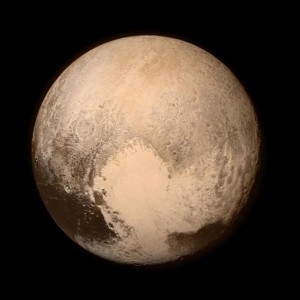We’ve made it to Pluto by NASA’s calculations, the last stop on a planetary tour of the solar system a half-century in the making.
The moment of closest approach for the New Horizons spacecraft came at 7:49 a.m. EDT (1149 GMT) Tuesday, culminating a journey from planet Earth that spanned an incredible 3 billion miles (4.8 billion kilometers) and 9½ years.
Based on everything NASA knows, New Horizons was straight on course for the historic encounter, sweeping within 7,800 miles of Pluto at 31,000 mph. But official confirmation won’t come until Tuesday night, 13 nerve-racking hours later. That’s because NASA wants New Horizons taking pictures of Pluto, its jumbo moon Charon and its four little moons during this critical time, not communicating with Earth.
“This is truly a hallmark in human history,” said John Grunsfeld, NASA’s science mission chief.
The United States is now the only nation to visit every single planet in the solar system. Pluto was No. 9 in the lineup when New Horizons departed Cape Canaveral, Florida, on Jan. 19, 2006, but was demoted seven months later to dwarf status. Scientists in charge of the $720 million mission, as well as NASA officials, hope the new observations will restore Pluto’s honor.
Inside “countdown central,” hundreds jammed together to share in the remaining final minutes, including the two children of the American astronomer who discovered Pluto in 1930, Clyde Tombaugh. The actual flight control room was empty save for a worker sweeping up; the spacecraft was preprogrammed for the flyby and there was nothing anyone could do but join in the celebration.
It takes 4½ hours for signals to travel one-way between New Horizons and flight controllers, the speed of light. The last time controllers heard from the spacecraft was Monday night, according to plan.
New Horizons already has beamed back the best-ever images of Pluto and big moon Charon. The pictures are “mind-boggling to put it mildly,” NASA Administrator Charles Bolden said.
PLUTONIAN TIDBITS:
- Pluto takes 248 years to go around the sun (The Earth, one). Pluto has made it only a third of the way around the sun in the past 85 years.
- The amount of sunlight that reaches Pluto is so dim that high noon looks like twilight on Earth.
- Signals take 4½ hours to travel one-way between New Horizons and flight controllers in Maryland.
- Pluto is only 1,400 miles (2,300 kilometers) wide, about half the width of the United States. Pluto is slightly smaller than Earth’s moon.
- One day on Pluto is about 6½ days on Earth.
- Pluto was named by an 11-year-old girl from England.
- The temperature on Pluto can reach nearly 400 degrees below zero and has an atmosphere rich in Nitrogen.
- Pluto was demoted from a planet to a dwarf planet because a larger planet-like object was found in the solar system, named Eris. This caused astronomers to re-evaluate the attributes of a planet. Controversially, Pluto did not make the cut.
The newest pictures, from the actual flyby, won’t be transmitted until well afterward so the seven science instruments can take full advantage of the encounter. In fact, it will take more than a year to get back all the data.
On the eve of the flyby, NASA announced that Pluto is actually bigger than anyone imagined, thanks to measurements made by the spacecraft. It’s about 50 miles bigger than estimated, for a grand total of 1,473 miles in diameter.
Pluto is now confirmed to be the largest object in the so-called Kuiper Belt, considered the third zone of the solar system after the inner rocky planets and outer gaseous ones. This unknown territory is a shooting gallery of comets and other small bodies.
If a mission extension is granted, New Horizons will seek out another Kuiper Belt object before heading out of the solar system — for good.
Story by Associated Press
 CGTN America
CGTN America
